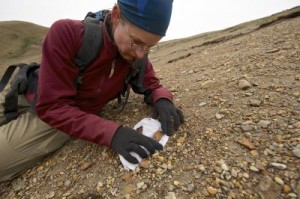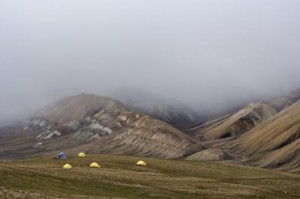Best known for traveling across inhospitable deserts, camels may have gotten their start in a radically different environment.
Fossil fragments of an extinct camel’s leg, discovered in Canada’s High Arctic by a research team led by the Canadian Museum of Nature, supports the view that camel ancestors originated in North America.
This find “extends the previous range of camels in North America northward by about 1,200 kilometers [745 miles], and suggests that the lineage that gave rise to modern camels may have been originally adapted to living in an Arctic forest environment,” said Dr. Natalia Rybczynski, a vertebrate paleontologist with the Canadian Museum of Nature.
Between 2006 and 2010, researchers collected 30 fossil fragments from a site on Ellesmere Island, Nunavut. The results of their discovery were published Mar. 5 in the online journal Nature Communications.
The bone pieces found at the Fyles Leaf Bed site are estimated to be 3.5 million years old, placing the extinct camel in the mid-Pliocene Epoch. Previous fossils discovered at the same site included only leaves, wood and other plants, making this the first mammal find at this location.
Other fossil finds suggest that the extinct camel was living in a boreal-type forest—still typical of much of Canada today—although at the time the Earth was undergoing a global warm period.
 Identifying this ancient ship of the Arctic from fossil fragments was no small feat.
Identifying this ancient ship of the Arctic from fossil fragments was no small feat.
“The first time I picked up a piece, I thought that it might be wood. It was only back at the field camp that I was able to ascertain it was not only bone, but also from a fossil mammal larger than anything we had seen so far from the deposits,” said Rybczynski.
Researchers used a 3D laser scanner to create digital images of the 30 bone fragments. Putting together these digital pieces—like a one-humped jigsaw puzzle—revealed the leg of a very large mammal. At the time, camels were the largest mammals in North America.
To confirm their suspicions, the researchers turned to collagen fingerprinting. This technique involves using chemical markers to create a profile for very small amounts of collagen extracted from the bone. The extinct camel’s collagen signature most closely matched modern camels, as well as the extinct Yukon giant camel that is thought to be Paracamelus, the ancestor of modern camels.
In addition to extending the range of extinct camels further into the High Arctic, this new discovery provides scientists with a better understanding of the evolution of camels.
Camel ancestors are thought to have originated in North America 45 million years ago. Because the new fossils are likely in the same lineage as Paracamelus, that means the camels that now sail the seas of sand in Northern Africa and the Middle East may have first developed in the less harsh woodlands of Northern Canada.
“So perhaps some specializations seen in modern camels, such as their wide flat feet, large eyes and humps for fat may be adaptations derived from living in a polar environment,” said Rybczynski.
__________
Reference: Rybczynski, N., Gosse, J., Richard Harington, C., Wogelius, R., Hidy, A., & Buckley, M. (2013). Mid-Pliocene warm-period deposits in the High Arctic yield insight into camel evolution Nature Communications, 4 DOI: 10.1038/ncomms2516
Photos:
- Camp 2, Fyles Leaf Bed Site and Dr. Natalia Rybczynski: Martin Lipman, Canadian Museum of Nature
- High Arctic camel illustration: Julius T. Csotonyi








